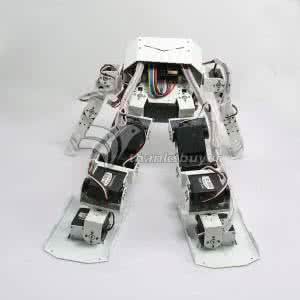Serially connected robots are promising candidates for performing tasks in confined spaces such as search-and-rescue in large-scale disasters. Such robots are typically limbless, and we hypothesize that the addition of limbs could improve mobility. However, a challenge in designing and controlling such devices lies in the coordination of high-dimensional redundant modules in a way that improves mobility. Here we develop a general framework to control serially connected multi-legged robots. Specifically, we combine two approaches to build a general shape control scheme which can provide baseline patterns of self-deformation ("gaits") for effective locomotion in diverse robot morphologies. First, we take inspiration from a dimensionality reduction and a biological gait classification scheme to generate cyclic patterns of body deformation and foot lifting/lowering, which facilitate generation of arbitrary substrate contact patterns. Second, we use geometric mechanics methods to facilitates identification of optimal phasing of these undulations to maximize speed and/or stability. Our scheme allows the development of effective gaits in multi-legged robots locomoting on flat frictional terrain with diverse number of limbs (4, 6, 16, and even 0 limbs) and body actuation capabilities (including sidewinding gaits on limbless devices). By properly coordinating the body undulation and the leg placement, our framework combines the advantages of both limbless robots (modularity) and legged robots (mobility). We expect that our framework can provide general control schemes for the rapid deployment of general multi-legged robots, paving the ways toward machines that can traverse complex environments under real-life conditions.
翻译:连连连连的机器人在大规模灾难中执行搜索和救援等封闭空间任务的可能性很大。 这些机器人通常是无足轻重的,我们假设增加四肢可以改善流动性。 然而,设计和控制这些装置的挑战在于高维冗余模块的协调,这样可以提高流动性。 我们在这里开发一个总框架来控制连连多腿机器人。 具体地说, 我们将两种方法结合起来, 来构建一个总体形状控制系统, 以提供在各种机器人形态中有效移动的多畸形( “ 藻类” ) 基线模式。 首先, 我们从一个维度减缩和生物齿轮分类计划中得到灵感, 以产生身体畸形和脚抬升/降的周期性模式, 从而便利产生任意的亚脚接触模式。 其次, 我们使用几何机械方法来帮助确定这些不相连接的机器人的最佳阶段化, 以最大限度的速度和/ 或稳定性。 我们的计划允许在多腿形机器人在不固定的轨道结构下发展有效的阵列式阵列式阵列式模式, 以平坦的平坦的机型机型机型机体构造结构结构, 机体的机体机体机体机体机体机体机体的机体机体机体机体机体机体机体机体机体机体机体机体机体机体机体机体结构, 4, 和机体机体机体机体机体机体机体机体机体机体的机体的机体的机体的机体的机体的机体的机体的机体结构。




